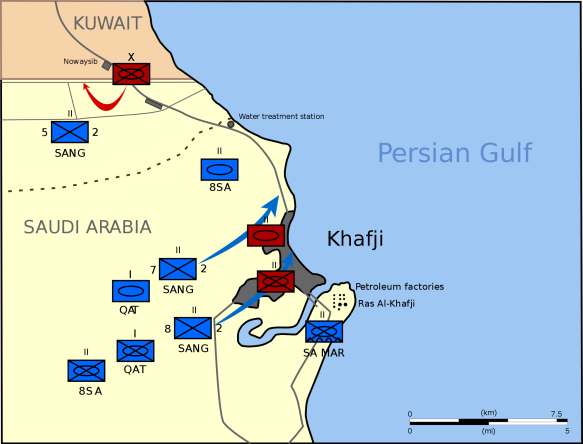While American air and military power grew, the two sides’ diplomats growled at each other. Hussein may have misjudged Western resolve because of the weakness with which Jimmy Carter had acted-or failed to act-when Iran had kidnapped American embassy staff in Tehran. President Bush was cut from sterner stuff and built a decisive military and political coalition to defeat the Iraqi invasion. By January hosts of modern fighter planes faced Iraq’s aging Mirages, and a large U. S.-led army had shouldered up to the Kuwaiti- Iraqi border. The only question was the ability of the American armored forces, who hadn’t seen serious action in fifty years. If Saddam’s troops could sufficiently bloody the Americans, he must have hoped that the pacifist and isolationist elements of the American Congress would win his battle for him. He ordered his army into action.
A few hours after darkness fell on January 29, 1991, U. S. Marine Corps outposts along the border reported the advance of a major Iraqi armored attack. Realizing that they were terribly outnumbered, the marines loaded into their vehicles and fled Khafji five minutes before the T-62s of the Iraqi 3rd Armored Division rolled over their now empty post.
The Iraqis were advancing in three distinct spearheads, two moving at positions to the west and one striking down the coastal highway. The 1st Mechanized Division was assigned the task of guarding the western flank of the attacking forces. The 3rd Armored Division was to cross the Saudi- Kuwaiti border south of Wafra and then strike against the Saudi port of MisUhab. Simultaneously, the 5th Mechanized Division was to strike straight down the coast, clear out the Saudi forces posted on the border, then push south to link up with the 3rd Armored Division near MisUhab. This was the spearhead of the only Iraqi advance into Saudi Arabia, and it was intended to be their major assault on the Saudis. If successful it would break the political back of the coalition.
The westernmost column consisted of a T-62 tank battalion and armored personnel carriers drawn from the 1st Mechanized Division. The central column was formed by elements of the 3rd Armored Division and contained about fifty tanks and thirty armored personnel carriers. The eastern column contained forty or more tanks and armored personnel carriers and moved directly down the coastal road. Once spotted, all three columns were brought under continuous air attack.
The 5th Mechanized Division’s line of advance led it through the city of RaUs al Khafji, an oil and resort city on the Persian Gulf coast, about eight miles from the Kuwaiti border. Because of its proximity to Kuwait, when the war erupted, the Saudis had evacuated its 15,000 inhabitants. The city was garrisoned by a battalion of the Saudi National Guard and a Qatari tank battalion, and supported by a U. S. liaison team intended to provide artillery support from the U. S. ships or aircraft as appropriate.
The Iraqi 5th Mechanized Division attacked southward, capturing Al Khafji, chasing from it the Saudi National Guard and Qatari forces that had garrisoned the city.
A counterattack was quickly mounted by Saudi National Guard and the Qatari armored forces, accompanied by a few U. S. marines and supported by massive American air attacks. The counterattack had little finesse, and the Saudis rolled through the streets of southern Khafji firing wildly. The Iraqis fired back with as little discipline, resulting in an utterly chaotic battle with little or no direction from above. The counterattack was repulsed. When the morning of January 30 arrived, the Iraqis still held Khafji.
The next morning the 2nd Saudi National Guard again advanced into Khafji supported by two companies of Qatari tanks that positioned themselves to block Iraqi reinforcements that might move against the city. The Qatari AMX-30S tanks being particularly effective in the retaking of Khafji when engaging Iraqi tanks. The Saudis again drove into the city, Saudi officers screaming into bullhorns demands that the Iraqis surrender. Iraqi defensive fire slowed the Saudi thrust, bringing some pause to the battle. The Saudis, however, were not to be denied and resumed their attack. Eventually they cleared the city and recaptured it, claiming 30 Iraqis killed, 37 wounded, and 429 prisoners. Their attack had cost them 19 dead and 36 wounded. During the attack the allied air strikes claimed to have inflicted 2,000 casualties on the Iraqis and to have destroyed 300 vehicles. The Iraqi 5th Mechanized Division was virtually destroyed. Ground engagements cost it 40 tanks and many armored personnel carriers. The Allied command reported destroying 544 tanks, 314 armored personnel carriers, and 425 artillery pieces between January 29 and February 3 in all parts of the war zone. Most of these were from the corps that had attacked Khafji.
The Battle of Khafji was the only offensive by the fourth-strongest army in the world. Instead of attacking, the Iraqis built massive sand fortifications of the type that had served so well against Iran. These fortified dunes, and their dictator’s bluster, were to be equally ineffective against the Allied bombing, or the armored assault that followed.
